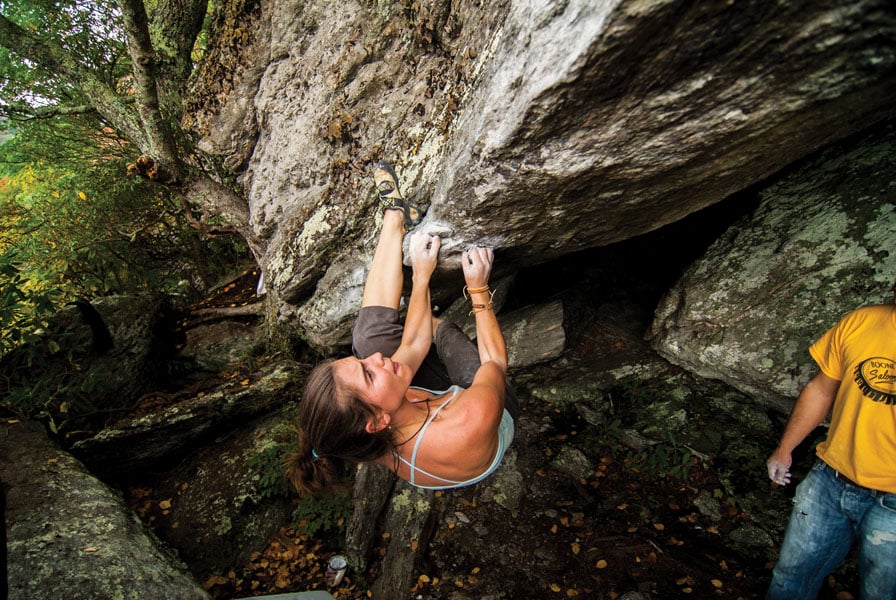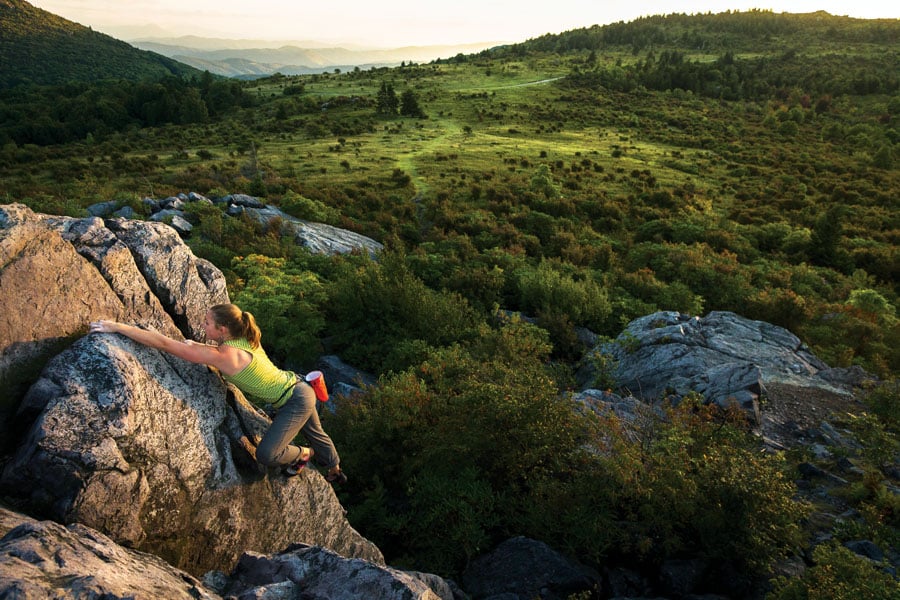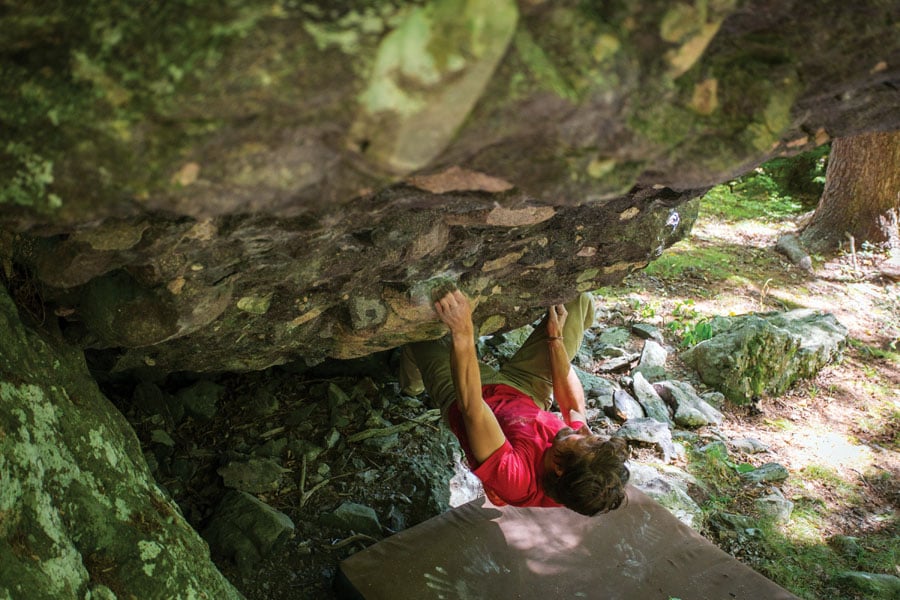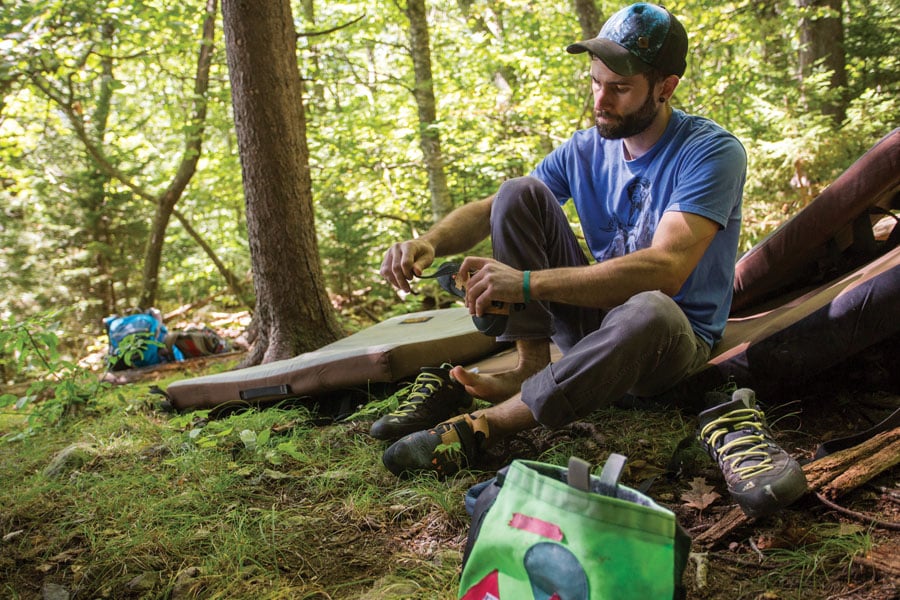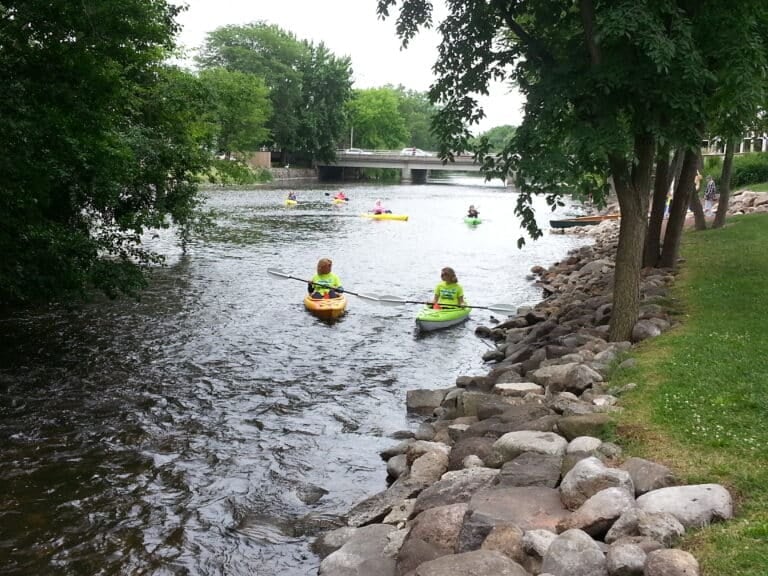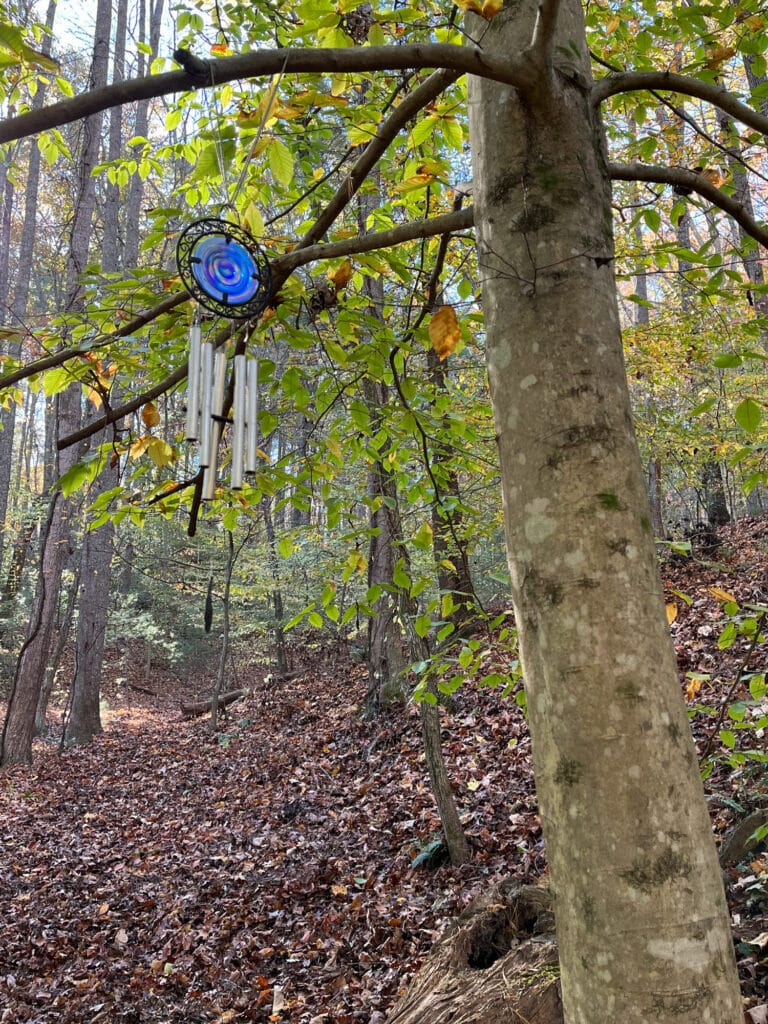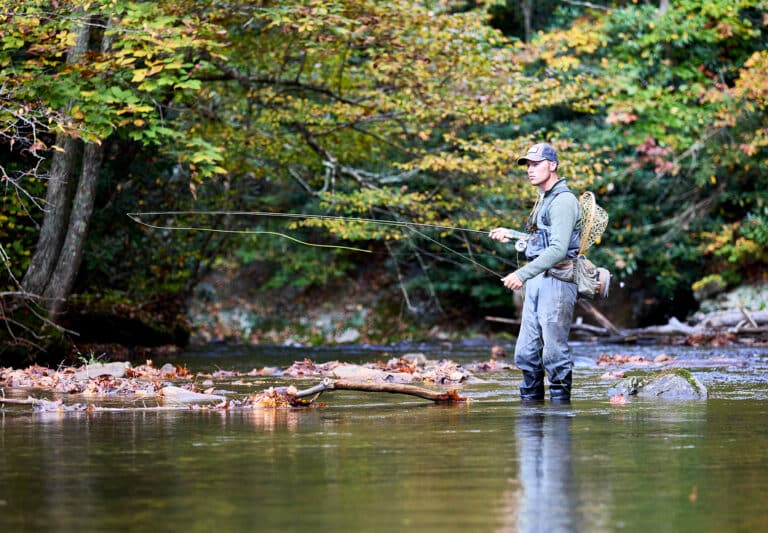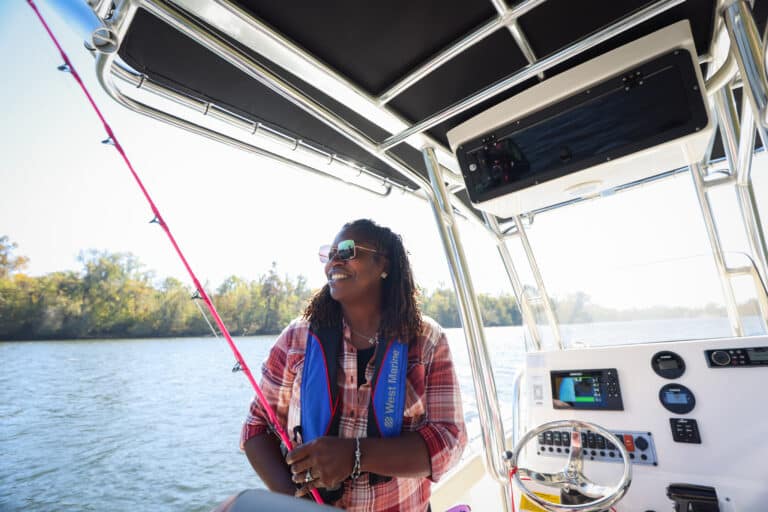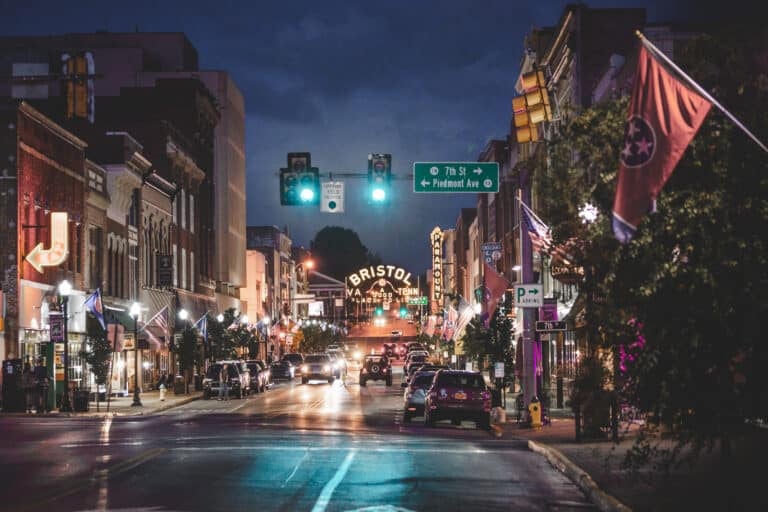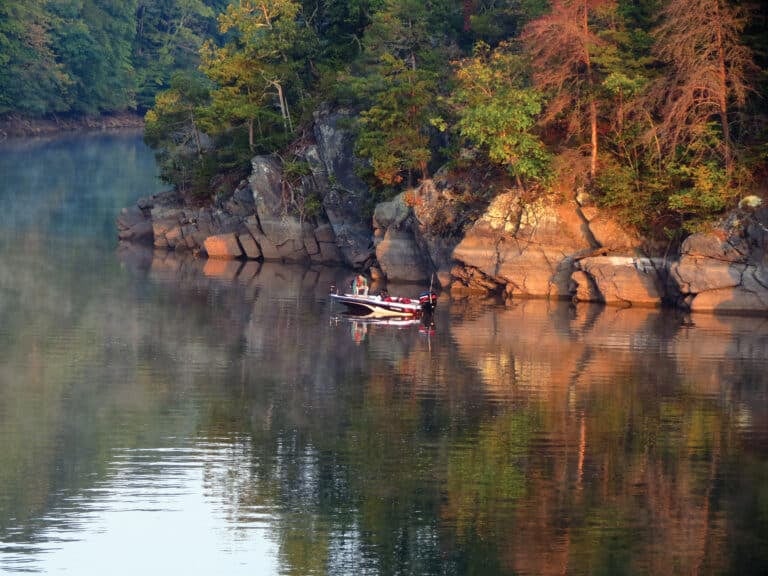Photo by Dan Bryak
The history of bouldering in Boone is fraught with access issues, bulldozers, and controversy. Where did it all begin, and what does the future hold for a sport that, in the beginning, was never considered a sport at all?
In the beginning there were ropes and shoes, makeshift harnesses and gear. Rock climbing in even its earliest form was much like what you and I think of it today, except without the mainstream “cool” factor, about a fifth of the participants, and double the gumption.
But if traditional rock climbing was considered “anti-establishment” then, during the ‘60s and ‘70s when big wall first ascents barely attracted national notice, the sport of bouldering was like a redheaded stepchild, the wannabe of climbing counterculture.
In fact, few considered it a sport at all. Up until the age of, and even decades after, John Gill, who is largely considered the first true American boulderer, bouldering was simply a means to an end, a way for French mountaineers to train in the off-season for alpine climbs. It was the earliest version of a hangboard you could find.
For John Gill, though, who came from a background of gymnastics, bouldering afforded climbers not only the chance to grow stronger, but to also improve technique and test acrobatic-like dynamic movements.
In the mid-‘50s, Gill decided to completely ditch the rope and embrace bouldering for good. He spent most of the next decade bouldering in places like Georgia’s Stone Mountain as well as Alabama’s Shades Mountain and DeSoto State Park while working toward a master’s degree in mathematics at the University of Alabama. Though he would go on to discover and send 19 boulders across the continental United States, the seeds Gill planted in the South took root and over the next 30 years, helped move the sport from the fringes of climbing to center stage.
Jim Horton of Boone, N.C., was one of those climbers inspired by the path that John Gill paved. It took only two outings for Horton to realize, “bouldering was for me.” And by bouldering, that sometimes meant not climbing at all but hiking, biking, scouting boulders from ridgelines and then bushwhacking for hours through overgrown rhododendron to get there. “Most of the time, it was a wild goose chase,” Horton remembers. “Even if you found a rock it might have a landing that was too severe or a route that wasn’t short enough.”
But that was hardly discouraging. Boone was ripe with metasandstone rock formations just waiting to be found, a treasure hunt through a sub-alpine forest fairly tale. Horton and local climbing legends such as Joey Henson, Eddie Blackledge, and Mike Grimm spent long hours scouring the woods of Boone in search of rock, landing their focus mainly on boulders off of US-221, Grandfather Mountain, and Howard’s Knob.
Horton’s own handiwork as a trail builder and problem developer can be seen all over Hound Ears, a gated community to the south of Boone that guards some of the best bouldering in town—yes, guards, as in fence, security watch, surveillance cameras. The boulders at Hound Ears are technically off-limits to climbers but, thanks to the efforts of Horton, the Hound Ears Club opens up their grounds to the dirtbag masses for just one day a year to kick off the Triple Crown Bouldering Series. Since Horton first organized the Hound Ears bouldering competition 22 years ago, he’s managed to maintain that once-a-year access for all but one year and says the sport of bouldering has exploded since those days of bushwhacking with his cronies.
“During that time I’ve seen younger and younger people show up to the competitions,” Horton says. “The women’s category is much larger than it used to be, with both sexes going more toward 50/50.”
The reason for this upsurge in popularity? None other than the climbing gym movement.
Photo by Jess Daddio
In the early ‘90s, when Horton was just a college kid at Appalachian State (and the local bouldering spot, Howard’s Knob, was still open to climbing), artificial climbing walls were hardly commonplace, let alone 13,000-square-foot facilities designed specifically for bouldering. Now, according to Climbing Business Journal, there are 436 climbing gyms across the country and over 200 bouldering competitions per year.
“Colleges, and even high schools, have climbing teams and climbing walls,” Horton adds. “It’s really taken off.”
Climbers in Boone, though, haven’t exactly felt the effects of bouldering’s upswing. Maybe it’s the predictably wet climate that keeps visitors at bay (56 inches of rain per year), or perhaps it’s that bouldering areas in Boone aren’t concentrated in one specific area—according to Boone-area climber Pat Goodman there’s “a roughly 30-mile corridor paralleling Highway 221 and the Blue Ridge Parkway,” keeping even weekend fall crowds relatively spread out.
But mostly, you can blame, or thank, the High Country’s unstable history of climbing access for the relative solitude of Boone bouldering. During the mid-to-late-90s, as bouldering rose in popularity, so too did the housing industry. For a while, it seemed almost personal—as climbers unveiled boulders on the outskirts of Boone, developers were just as quick to snatch those areas up, kick climbers out, and occasionally, bulldoze the boulders altogether.
“No one is going to compete with developers,” says Paul Fuelling, a Boone boulderer and local wood worker. “They’re millionaire billionaires. All we can do is suck it up and move on.”
Fuelling moved to the High Country 15 years ago. By that time, some of Boone’s earliest bouldering gems had already been discovered and then taken away, either at the hands of developers or environmentalists protecting rare plant life in the High Country. Though most of the present-day boulder fields were already well established, that didn’t stop Fuelling, his wife Kim, and friend Pat Goodman from pushing the envelope on highball boulder problems and exploring Pisgah National Forest for more rock.
“You gotta earn it,” Fuelling says of bouldering in the High Country. “It’s not just handed to you in a $12 guidebook. You gotta come here and poke around and talk to people and make friends.”
His comment about the guidebook? It’s not just a metaphor. Boone has never had a guidebook on bouldering, nor, it seems, will it ever. That fact alone has fueled a reputation of Boone among climbers as being a “locals only” community, one that shuns newcomers and hoards the area’s secret rock.
Of course, that distinction couldn’t be farther from the truth.
“It’s just not something that needs to be advertised to every gym climber in the U.S.,” Fuelling says, citing the new-age climbers’ lack of environmental ethics as a threat to Boone’s delicate access. “It’s like, yeah, you’re allowed to be climbing at Grandmother, but you have to realize that [the Forest Service] goes up there every year and looks at the trails and decides whether or not they are going to continue to let us do that.”
“It’s kinda hard to release a guidebook to climbing places you might not have access to a year later,” Horton adds.
What’s more, state park officials and private landowners who aren’t familiar with climbing know only what the media portrays of the sport, which, in recent years, has involved extreme examples such as Alex Honnold’s free-solo ascents of big wall climbs like El Capitan and Half Dome.
“A lot of times, we’re fighting that negative image [that the sport is dangerous] or that glorified image of climbing, to secure our access,” Horton says.
Almost ironically, the climbers who are crowding the crags but also helping to change that glorified image are of a younger generation, one that grew up with commodities like the Internet, cell phones, and, of course, climbing gyms.
“I didn’t even know bouldering was a thing until I walked in my first indoor climbing gym in North Carolina and figured out there was a whole community around it,” says Adkins, Va., native Aaron Parlier.
At 29 years old, Parlier has already made his mark on bouldering in the Southeast, specifically in his home state of Virginia. In 2013, Parlier published the first bouldering guidebook to Grayson Highlands State Park, an area mostly known for its feral miniature pony herds, sweeping vistas, and wild blueberry season. While serving for AmeriCorps at Grayson Highlands, Parlier utilized his schooling interests in land management to help the park not only develop the bouldering but also conceptualize and implement a climbing impact management plan.
Photo by Jess Daddio
“There wasn’t a lot of information at all on climbing in southwest Virginia,” says Parlier, who climbed while attending Virginia Tech. “I knew in the back of my mind that there were really nice sandstone areas and boulders in Grayson Highlands, but that exploration happened by default. There was no one talking about it, no knowledge of it. Whether or not you were wanting to climb on new rocks, you were going to be.”
Of course, Grayson Highlands had seen climbers before, whether or not the rangers there knew of it. Horton, in fact, put up many of the original problems in the park, but in the pre-Internet, access-sensitive age of climbing, there wasn’t much in the way of documentation.
“When I saw the park rangers come, I ducked further into the woods,” Fuelling remembers of early trips to Grayson. “Now I don’t have to.”
Parlier, who just finished graduate school at Appalachian State University in Boone, says that, while North Carolina climbers have been climbing at Grayson Highlands for decades, there was always a bit of trepidation when it came to developing the area to the point of public promotion.
“A lot of climbers assumed the climbing in Grayson would instantaneously be banned because that happened to a lot of places here in Boone,” he says. “Right over the North Carolina border, a lot of state parks are really apprehensive [to climbing] whereas southwest Virginia is really open to it and proactive. [Grayson’s bouldering scene] has also set the stage for other communities in southwest Virginia like Norton and Wise County to get on board.”
The Grayson Highlands Bouldering Guide includes 300 choice boulder problems, but according to Parlier, there are now over 1,000 problems across the park. He says plans are already in the works for a second volume. On any given weekend, the park’s four rental crash pads are rarely in the visitor’s center, spare chalk is out of stock, and the parking lots are full.
The success of Grayson hasn’t gone unnoticed. In fact, even Boone’s gated communities and clubs are starting to see the benefits of supporting outdoor recreation activities like hiking, biking, and even climbing.
“Golf clubs are losing some popularity and outdoor activities are being seen as an amenity that a lot of these clubs are wanting to add to the list of offerings,” Horton says.
Though the local climbing community has tried, and failed, numerous times to outright purchase and protect Hound Ears bouldering in perpetuity, Horton doesn’t think the acquisition is impossible. And with environmentally conscious, respectable young climbers like Parlier filtering through the university every few years, Horton has high hopes of changing the climbing stigma.
“We host a locals’ day at Hound Ears to clean up around the boulders and have even helped Grandfather with trail repair, even though we’ll probably never have access to any of the boulders there,” he says. “We do it so people can see what good people climbers are.”
Between trail days, kids’ clinics, and even plans for a bouldering gym (at the hands of Parlier) it’s hard to imagine where Boone’s reputation for being clandestine and territorial could have originated. For 21-year-old App State student and boulderer Carson Bakker, that aloof attitude toward out-of-towners was something he never encountered.
“Personally, I think it’s kinda cool that you have to strike up conversation to find the climbing,” Bakker says in regards to the guidebook, or lack thereof. “When I think about Boone climbing, there’s something about the thought of people showing up with a nose in a guidebook that doesn’t sit well with myself or the majority of climbers here.”
Respectful and diligent, proactive and persistent, climbers in Boone may be protective of their boulders, yes, but with good reason. If the place you love to play had a history sprinkled with bulldozers and dynamite, you’d probably be willing to strap yourself to a tree to protect it, right?
“We have these great climbing areas but we know they might not be permanent,” Bakker says. “We know we have to act a certain way and treat those areas with respect or they might not be there forever.”
So what does the future hold for Boone and its boulders? For now, it’s simply a matter of maintaining access to the major boulder fields where climbing is permitted, namely 221 Boulders, Lost Cove, Grandmother Mountain, and Blowing Rock. For climbers with a knack for adventure and the willingness to stray off the beaten path, there are plenty of undeveloped boulders, especially down in the Linville Gorge and Watauga River Gorge where access can be cumbersome but is free and open to the public.
Grounded on the principle of work hard, play hard, bouldering in Boone celebrates the ambitious. But the Golden Age of bouldering is far from over in this mountain town. Local climber Rami Annab recently snagged the first ascent of one of the community’s longstanding problems, a 30-foot, V11 highball dubbed The World is Not Enough. His accomplishment, revered even by the original Boone climbers, echoes Fuelling’s sentiment that, if you’re willing to put in the time to earn it, the jewel of the High Country can be yours.
